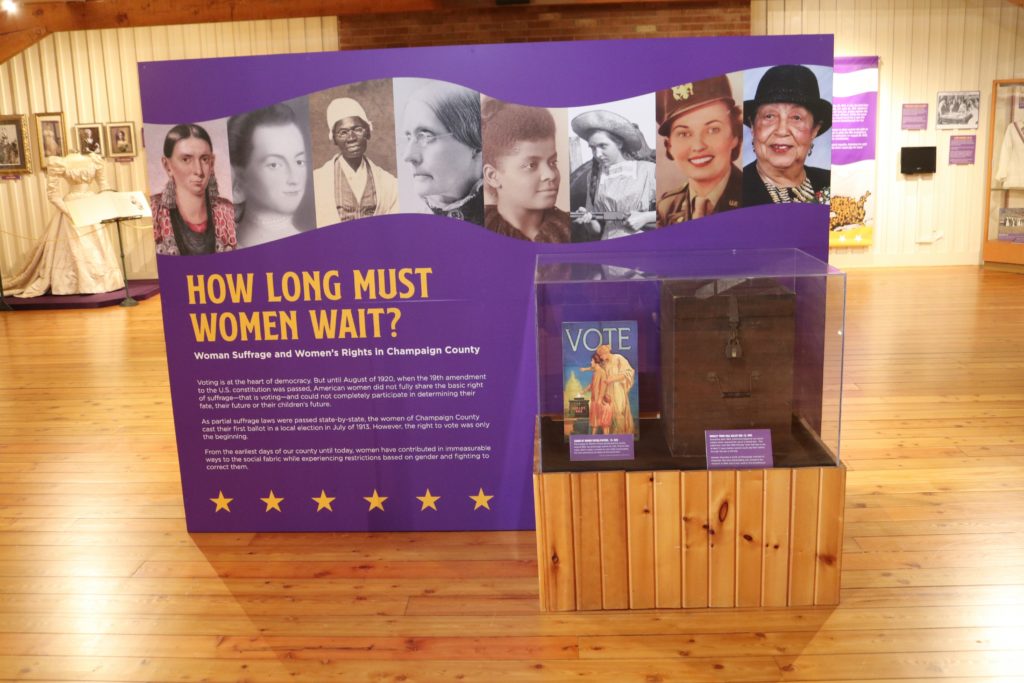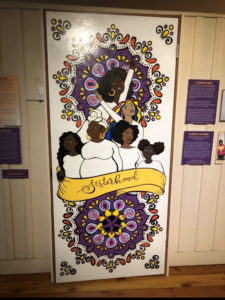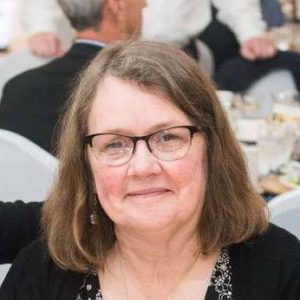
The exhibit at Museum of the Grand Prairie
Ever wondered why March is Women’s History Month? We at the Museum of the Grand Prairie invite you to answer that question with a visit to our latest exhibit celebrating the centennial of women’s voting rights, “How Long Must Women Wait? Woman Suffrage and Women’s Rights in Champaign County.” While this exhibit opened in 2020, we’re holding it over because of our previous COVID-related closures. On March 1 we will reopen our doors to the public just in time for you to join us in celebrating Women’s History Month.
You can thank the suffragists for Women’s History Month. Concurrent with their struggle for the vote, the first Women’s History Day happened in March, 1909. Presidential proclamations stretched that into a week in the 1970s and a month in the 1990s, but the question remains, why March?
It is possible that March is the month for marching. The first ever march on Washington D.C. occurred on March 3, 1913, and was spearheaded by Alice Paul and the National American Woman Suffrage Association. Paul thought that the suffrage issue had to be made nationally visible. That very visible march happened the day before the inauguration of Woodrow Wilson and disrupted the Presidential festivities. Eight thousand suffragists from across the country and the world paraded up Pennsylvania Avenue, with floats, bands, and mounted brigades.
Among those demonstrating were three women from Champaign County: Lillie Belle Sale, Eliza Vincent, and Edith Dobbins. Lillie Belle Sale was the mother of Chick and Virginia Sale, renowned vaudevillians. Eliza Vincent was a schoolteacher from Rantoul, and Edith Dobbins the wife of a prominent Champaign lawyer, who would later be mayor of the city. When they returned, they reported on their experiences to the local Twin City Equal Suffrage League, an organization which would eventually morph into the League of Women Voters after suffrage was achieved.

Eliza Vincent and Lillie Belle Sale
The local component of the women’s suffrage story actually began decades earlier, when Mary Melissa Harris and Elgin Ray traveled to Washington, D.C. in March, 1888, to attend the first meeting of the National Council of Women. Susan B. Anthony, Elizabeth Cady Stanton, and Frances Willard headed that organization, which brought together women’s organizations of all types to deal with issues affecting women, including the right to vote.
Ray and Harris returned from the meeting “full of enthusiasm and ambition and an unbounded confidence in the ability of Twin City Women.” They were inspired to form the Social and Political Science Club, and brought together numerous other prominent locals, including Julia Burnham.
After much study, the Social and Political Science Club dropped the word “political” in 1892, becoming the Social Science Club and eventually the Champaign Social Science Club. In the fall of 1893, they decided that the community needed a hospital. Julia and her husband Albert Burnham put forward a founding donation of $10,000. The women secured a state charter; Burnham donated land and oversaw the building of Burnham Hospital, which served the city of Champaign until 1992.
The suffragist activism also helped inspire the creation of the original Champaign Public Library, the Burnham Athenaeum. It was founded with a $50,000 gift from Albert Burnham in memory of his wife Julia, whose Social Science Club activities led her to believe the city needed a free public library. Albert assured its completion after Julia’s death, and created a second story room in the library as a permanent meeting place for this progressive club.
Over in Urbana, Mary Busey—wife of Samuel Busey, the bank co-founder—was a major force in the Urbana suffrage movement. Just after the turn into the 20th century, she was hosting gatherings at her home to promote women’s right to vote. She was an officer of the Twin City Equal Rights Association, and was appointed in 1915 and 1916 to the Illinois Equal Suffrage Association. Busey was a philanthropist, giving funds to build the Urbana Free Library; and a longtime elected official, serving on the Urbana School Board from 1903 to 1906, and for 25 years on the University of Illinois Board of Trustees.
The ERA in Illinois—Almost 50 years in the Making
The museum’s exhibit isn’t just about the fight for suffrage; it includes the struggle to pass the Equal Rights Amendment (ERA) as well. Immediately after the passage of the 19th Amendment to the US Constitution granting women the vote, Alice Paul said, “If we keep on this way they will be celebrating the 150th anniversary of the 1848 Convention without being much further advanced in equal rights than we are . . . We shall not be safe until the principle of equal rights is written into the framework of our government.” Ms. Paul was right. While the ERA was originally passed in 1972 by Congress, it still needed three-quarters of the states to ratify it in order for it to become an amendment. By 1973, 30 of the 38 states needed had ratified the amendment. However, the Illinois legislature had already voted down the ERA in 1972. Throughout the 1970s and 1980s, local women worked, and marched, for equal rights in Champaign, in Chicago, and in Washington, D.C. Their buttons, T-shirts, and posters are included in the exhibit. Finally, in 2018, after nearly fifty years, Illinois became the 37th state out of the necessary 38 states to ratify.
A New Generation’s Struggles and Successes
And what about the women of today and tomorrow? The Museum of the Grand Prairie wanted to know how young women of today define their challenges. We wondered which doors they still feel are closed and which, through empowerment, they have opened for themselves.
To that end, we went to the young women of Sisterhood, at Franklin STEAM Academy in Champaign, to ask if they would like to collaborate with us to create a mural for this exhibit. Sisterhood Academy of Excellence is an after-school program specifically tailored to girls of color. Through activities and experiences such as the creation of this mural, the group helps the girls become well rounded while developing understanding of self-love, self-respect, ambition, comradery, and responsibility. The goal is to empower the girls of Sisterhood to change the world.

The girls of Sisterhood at the museum with their mural
We began with a field trip to the museum. The girls explored an exhibit, learned some background information on Women’s Suffrage and Women’s Rights, and learned about careers in museum work and what it takes to create an exhibit.
The girls then returned to school and began to work with artist Amanda Danowitz to create the mural that would become part of the exhibit. Their ideas of the doors that have been shut to them included: Oppression, Racism, Hidden, Classism, Sexism, Heterosexism, Silenced, Judgement, Hate, Insecurity, Shamed, and Colorism. Qualities the young women associated with the doors that they have opened for themselves through their own power included: Resilient, Fierce, Beautiful, Natural, Powerful, Intelligent, and Brave.

Close-up of mural
Working together with the artist and educators from Sisterhood, the young women have combined all these ideas to create a vibrant and imaginative mural that marks the road ahead for the women’s movement’s next chapter. It is a stunning contribution to our exhibit on the history of Champaign County’s women’s movement, and we hope you see it for yourself this spring.

Inner door of the mural
Beginning March 2, 2021, the museum will be open from 1–5 pm. Advance sign-up and masking is required. For more information, contact Pat Cain, pcain@ccfpd.org, or call (217) 586-2612. The Museum of the Grand Prairie is a facility of the Champaign County Forest Preserve District, and is located at 950 N. Lombard St., Mahomet, IL 61853.

Barb Oehlschlaeger-Garvey has been the director of the Museum and Education Department of the Champaign County Forest Preserve for eight years, having spent the previous twelve years as curator of the Museum of the Grand Prairie. She holds a Ph.D from the U of I in Art History and previously held positions at the Krannert Art Museum and World Heritage Museum. She has lived in Champaign’s sesquicentennial neighborhood for the last 33 years, where she is committed to preserving her neighborhood and building community.
